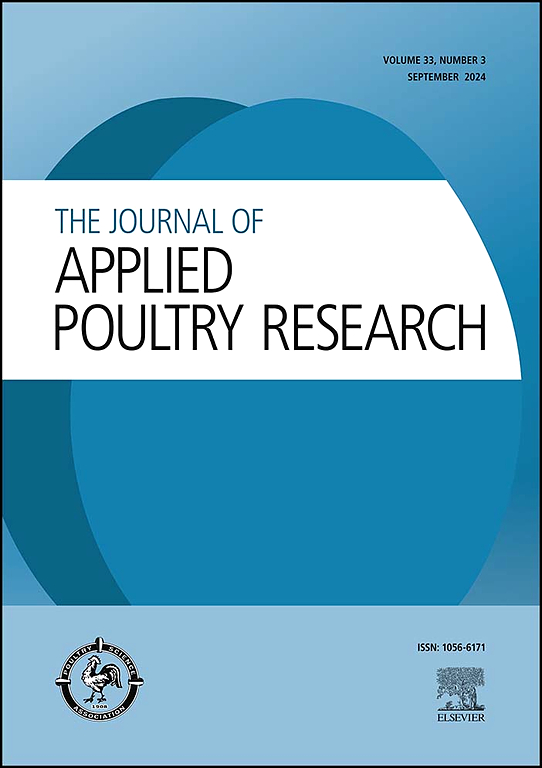Bioequivalence of a commercial polyherbal choline for replacement of choline chloride for broiler chickens
IF 2
3区 农林科学
Q2 AGRICULTURE, DAIRY & ANIMAL SCIENCE
引用次数: 0
Abstract
Choline is an indispensable nutrient in poultry diets to ensure optimal growth and health. Alternative sources of choline derived from herbal extracts have been increasingly used as replacements for choline chloride. The objective of this study was to determine the bioequivalence of a novel polyherbal choline source for broiler chickens up to 35 d of age. A total of 1,120 one-d-old male Cobb 500 chicks were distributed to 7 treatments and 8 replicate pens with 20 birds each. The experimental diets were: control (based on rice bran, corn gluten, and soybean meal); control supplemented with increasing levels of polyherbal choline (HC; 100, 200, and 300 mg/kg) and control supplemented with choline chloride 60 % (CC; 200, 400, and 600 mg/kg). Body weight gain (BWG), feed intake (FI), and feed conversion ratio (FCR) were calculated by phases. The effects of choline sources and levels were also assessed on leg deviations at 28 and 34 d, and breast and liver characteristics at 35 d. Data were subjected to ANOVA and regression equations were estimated for each choline source. Increasing levels of both choline sources reduced leg deviations and improved liver redness (a*). Comparing the regression slopes of HC with CC, bioequivalences at 3.34 and 2.43 were obtained for BWG and at 2.88 and 2.30 for FCR, from 1 to 28 and 1 to 34 d, respectively. Therefore, the bioequivalence values for BWG and FCR ranged from 1 unit of HC to 2.23-3.34 units of CC.
肉仔鸡用多草药胆碱替代氯化胆碱的生物等效性
胆碱是家禽日粮中保证最佳生长和健康不可缺少的营养素。从草药提取物中提取的胆碱的替代来源已越来越多地用作氯化胆碱的替代品。本研究的目的是确定一种新型多草药胆碱源对35日龄肉鸡的生物等效性。试验选用1龄Cobb 500雄性雏鸡1120只,分为7个处理和8个重复栏,每个重复栏20只。试验饲粮为:对照(以米糠、玉米蛋白和豆粕为基础);对照组补充增加多草药胆碱水平(HC;100、200和300 mg/kg),对照组添加氯化胆碱60% (CC;200,400和600mg /kg)。分阶段计算体增重(BWG)、采食量(FI)和饲料系数(FCR)。还评估了胆碱来源和水平对28和34 d时腿部偏差的影响,以及35 d时乳房和肝脏特征的影响。对每个胆碱来源的数据进行方差分析和回归方程估计。两种胆碱来源水平的增加减少了腿部偏差,改善了肝脏发红(a*)。对比HC与CC的回归斜率,在1 ~ 28 d和1 ~ 34 d期间,BWG的生物等效度分别为3.34和2.43,FCR的生物等效度分别为2.88和2.30。因此,BWG和FCR的生物等效值范围为1单位HC ~ 2.23 ~ 3.34单位CC。
本文章由计算机程序翻译,如有差异,请以英文原文为准。
求助全文
约1分钟内获得全文
求助全文
来源期刊

Journal of Applied Poultry Research
农林科学-奶制品与动物科学
CiteScore
4.10
自引率
10.50%
发文量
80
审稿时长
104 days
期刊介绍:
The Journal of Applied Poultry Research (JAPR) publishes original research reports, field reports, and reviews on breeding, hatching, health and disease, layer management, meat bird processing and products, meat bird management, microbiology, food safety, nutrition, environment, sanitation, welfare, and economics. As of January 2020, JAPR will become an Open Access journal with no subscription charges, meaning authors who publish here can make their research immediately, permanently, and freely accessible worldwide while retaining copyright to their work. Papers submitted for publication after October 1, 2019 will be published as Open Access papers.
The readers of JAPR are in education, extension, industry, and government, including research, teaching, administration, veterinary medicine, management, production, quality assurance, product development, and technical services. Nutritionists, breeder flock supervisors, production managers, microbiologists, laboratory personnel, food safety and sanitation managers, poultry processing managers, feed manufacturers, and egg producers use JAPR to keep up with current applied poultry research.
 求助内容:
求助内容: 应助结果提醒方式:
应助结果提醒方式:


